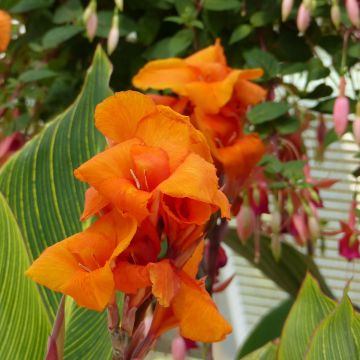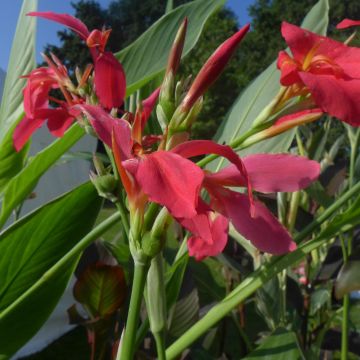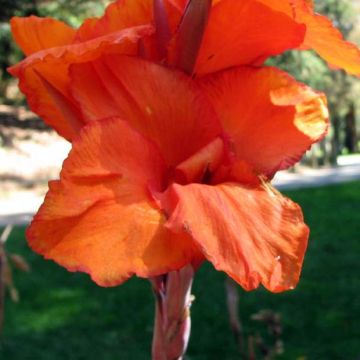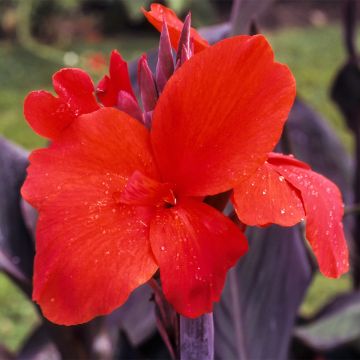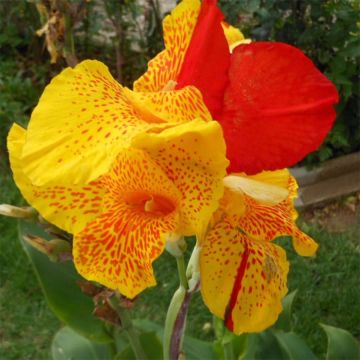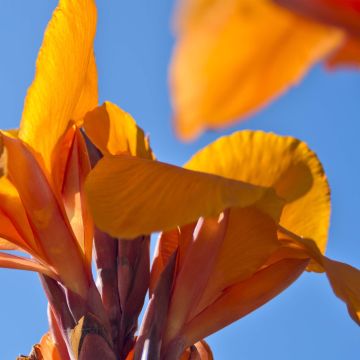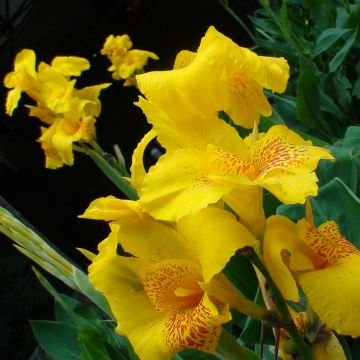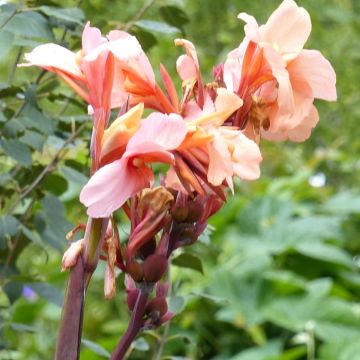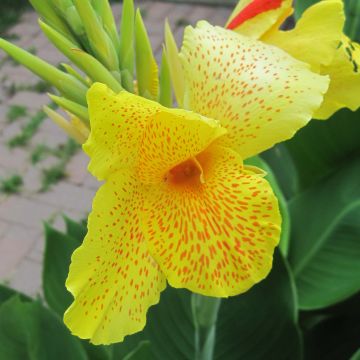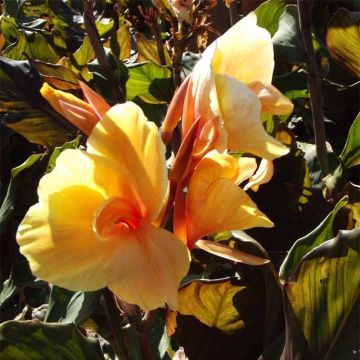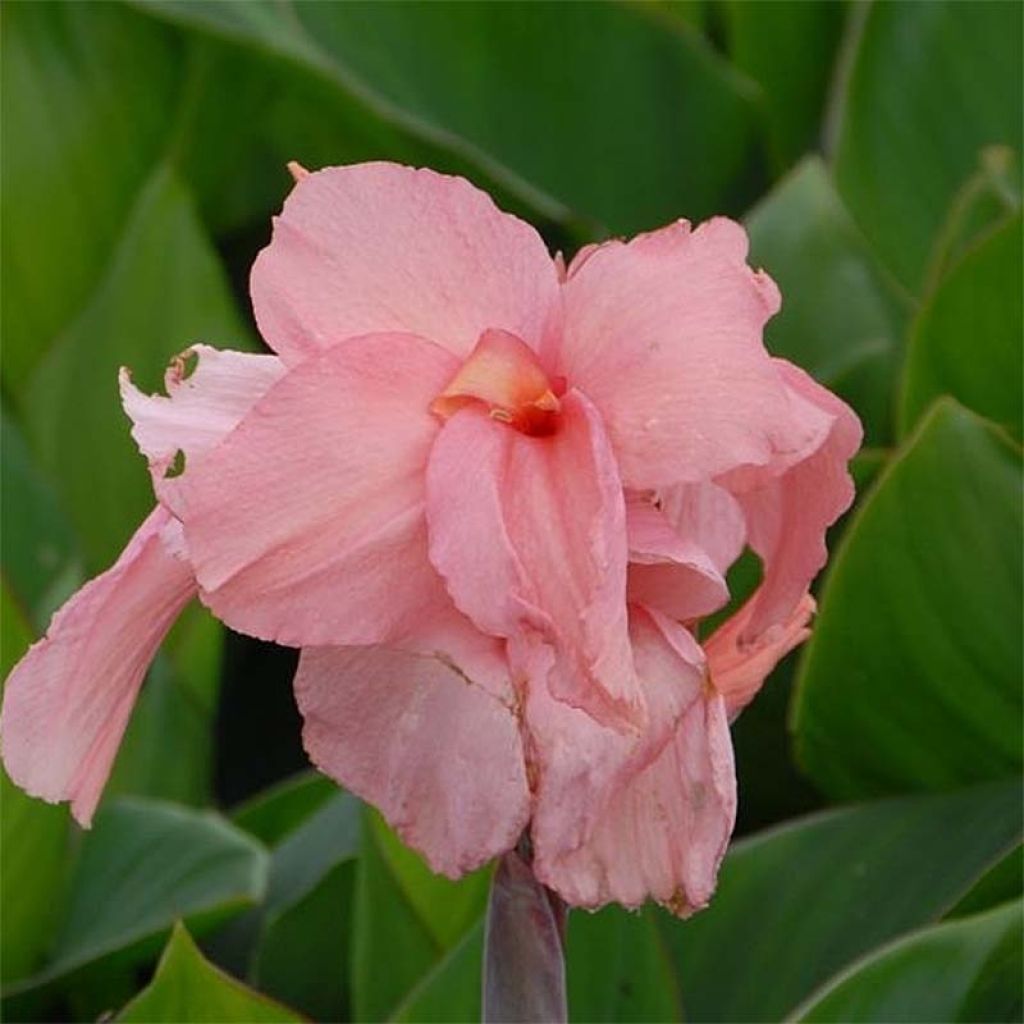

Canna indica Pink President - Indian shot
Canna indica Pink President - Indian shot
Canna indica Pink President
Indian shot, Canna, Cann Lily, African Arrowroot, Edible Canna, Purple Arrowroot, Sierra Leone Arrowroot
Very nice colour, true to the picture, rapid growth.
Béa, 19/09/2024
This item cannot be shipped to the selected country
Delivery charge from €5.90
More information
Schedule delivery date,
and select date in basket
This plant carries a 6 months recovery warranty
More information
We guarantee the quality of our plants for a full growing cycle, and will replace at our expense any plant that fails to recover under normal climatic and planting conditions.
From €5.90 for pickup delivery and €6.90 for home delivery
Express home delivery from €8.90.

Does this plant fit my garden?
Set up your Plantfit profile →
Description
The Canna 'Pink President' is a variety of modest stature that will charm with its long and magnificent summer flowering in a fresh and vibrant pink. It stands above ample green-blue foliage veined with darker green, in the form of spikes adorned with numerous large flowers reminiscent of gladioli. An easy plant to grow in rich and moist soil, which has its place on a very sunny terrace or in an exotic and lush garden.
The Canna x indica 'Pink President' is a herbaceous rhizomatous plant of the cannaceae family. It is a hybrid variety. Its ancestors are native to tropical areas of Asia and America. This canna quickly forms a clump measuring 75-80 cm (30-32in) in height and occupying about 60 cm (24in) of space. It forms large, entire, broad, oblong leaves with sheathing at the base. The lamina is a beautiful green-blue colou and entirely traversed by darker veins. The flowering, which occurs in summer, takes place from July-August to September-October, in the form of spikes of pink flowers. Each flower, measuring 8 to 10 cm (3 to 4in) in diameter, asymmetrical, is composed of3 petals fused at the base, 3 sepals and visible stamens. The plant easily multiplies vegetatively, by producing numerous shoots.
The Canna 'Pink President' allows for sumptuous compositions in containers, with a very exotic appearance, alongside agapanthus, amaranths and cosmos. It forms a beautiful combination with a banana tree or bamboo. Hybrid Cannas are majestic and colourful plants. The taller varieties are ideal for spicing up the back of borders for the taller ones, while the smaller varieties are ideal for brightening up terraces and balconies. Their cultivation is within everyone's reach. Consider planting them in a mass with about ten bulbs, of the same variety or by mixing green and purple foliage. Use them to adorn a corner of a pond in the company of colocasias, ferns, and ground cover species such as helxines or golden creeping jenny lysimachus. Cultivate this plant like a Dahlia. Dig up the rhizomes before the frosts and replant them in spring.
Report an error about the product description
Canna indica Pink President - Indian shot in pictures
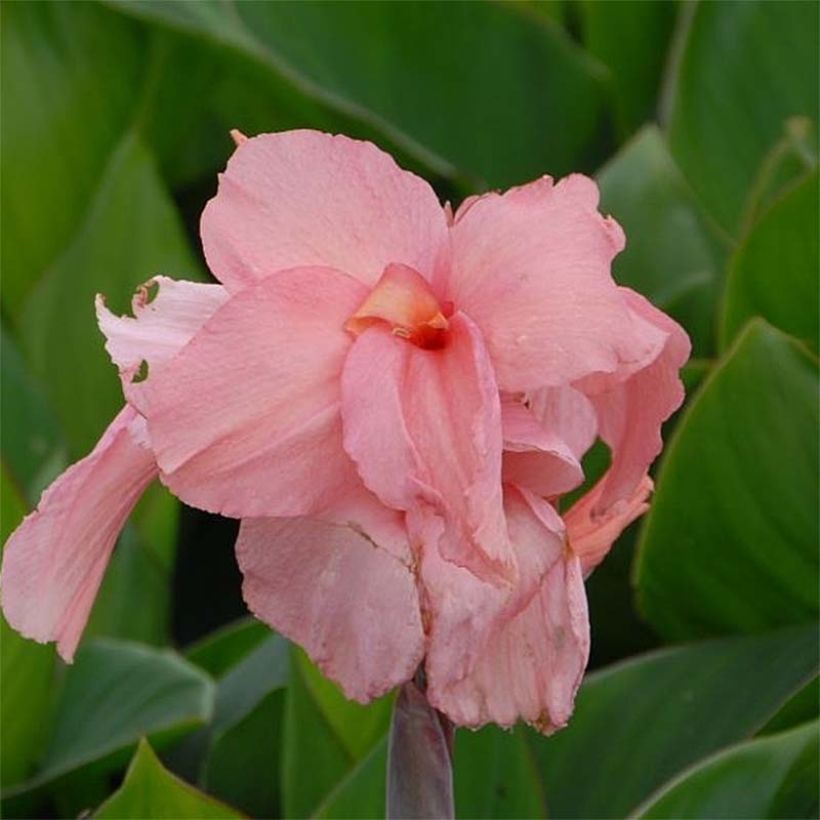

Plant habit
Flowering
Foliage
Botanical data
Canna
indica
Pink President
Cannaceae
Indian shot, Canna, Cann Lily, African Arrowroot, Edible Canna, Purple Arrowroot, Sierra Leone Arrowroot
Cultivar or hybrid
Other Cannas
Planting and care
The 'Pink President' Canna does not like the cold and must be protected from frost during winter. Its flowering will be more beautiful if it is planted in partial shade. It should be stored away at the first frost, to keep the rootstocks dry and cool, for example in a bit of turf. Only plant in the ground after the last frost. Plant them in moist but well-drained soil (if necessary, lighten your soil with turf or sand). Cover with 5 cm (2in) of soil, and keep a spacing of 40 cm (16in) between the bulbs. Apply organic fertilizer at planting and at least once a month. Regularly water so that the soil never completely dries out. You can also speed up their cycle by planting them in pots under frost-free shelter from February, and then transplanting them to the garden in the warmer months.
Planting period
Intended location
Care
-
, onOrder confirmed
Reply from on Promesse de fleurs
Haven't found what you were looking for?
Hardiness is the lowest winter temperature a plant can endure without suffering serious damage or even dying. However, hardiness is affected by location (a sheltered area, such as a patio), protection (winter cover) and soil type (hardiness is improved by well-drained soil).

Photo Sharing Terms & Conditions
In order to encourage gardeners to interact and share their experiences, Promesse de fleurs offers various media enabling content to be uploaded onto its Site - in particular via the ‘Photo sharing’ module.
The User agrees to refrain from:
- Posting any content that is illegal, prejudicial, insulting, racist, inciteful to hatred, revisionist, contrary to public decency, that infringes on privacy or on the privacy rights of third parties, in particular the publicity rights of persons and goods, intellectual property rights, or the right to privacy.
- Submitting content on behalf of a third party;
- Impersonate the identity of a third party and/or publish any personal information about a third party;
In general, the User undertakes to refrain from any unethical behaviour.
All Content (in particular text, comments, files, images, photos, videos, creative works, etc.), which may be subject to property or intellectual property rights, image or other private rights, shall remain the property of the User, subject to the limited rights granted by the terms of the licence granted by Promesse de fleurs as stated below. Users are at liberty to publish or not to publish such Content on the Site, notably via the ‘Photo Sharing’ facility, and accept that this Content shall be made public and freely accessible, notably on the Internet.
Users further acknowledge, undertake to have ,and guarantee that they hold all necessary rights and permissions to publish such material on the Site, in particular with regard to the legislation in force pertaining to any privacy, property, intellectual property, image, or contractual rights, or rights of any other nature. By publishing such Content on the Site, Users acknowledge accepting full liability as publishers of the Content within the meaning of the law, and grant Promesse de fleurs, free of charge, an inclusive, worldwide licence for the said Content for the entire duration of its publication, including all reproduction, representation, up/downloading, displaying, performing, transmission, and storage rights.
Users also grant permission for their name to be linked to the Content and accept that this link may not always be made available.
By engaging in posting material, Users consent to their Content becoming automatically accessible on the Internet, in particular on other sites and/or blogs and/or web pages of the Promesse de fleurs site, including in particular social pages and the Promesse de fleurs catalogue.
Users may secure the removal of entrusted content free of charge by issuing a simple request via our contact form.
The flowering period indicated on our website applies to countries and regions located in USDA zone 8 (France, the United Kingdom, Ireland, the Netherlands, etc.)
It will vary according to where you live:
- In zones 9 to 10 (Italy, Spain, Greece, etc.), flowering will occur about 2 to 4 weeks earlier.
- In zones 6 to 7 (Germany, Poland, Slovenia, and lower mountainous regions), flowering will be delayed by 2 to 3 weeks.
- In zone 5 (Central Europe, Scandinavia), blooming will be delayed by 3 to 5 weeks.
In temperate climates, pruning of spring-flowering shrubs (forsythia, spireas, etc.) should be done just after flowering.
Pruning of summer-flowering shrubs (Indian Lilac, Perovskia, etc.) can be done in winter or spring.
In cold regions as well as with frost-sensitive plants, avoid pruning too early when severe frosts may still occur.
The planting period indicated on our website applies to countries and regions located in USDA zone 8 (France, United Kingdom, Ireland, Netherlands).
It will vary according to where you live:
- In Mediterranean zones (Marseille, Madrid, Milan, etc.), autumn and winter are the best planting periods.
- In continental zones (Strasbourg, Munich, Vienna, etc.), delay planting by 2 to 3 weeks in spring and bring it forward by 2 to 4 weeks in autumn.
- In mountainous regions (the Alps, Pyrenees, Carpathians, etc.), it is best to plant in late spring (May-June) or late summer (August-September).
The harvesting period indicated on our website applies to countries and regions in USDA zone 8 (France, England, Ireland, the Netherlands).
In colder areas (Scandinavia, Poland, Austria...) fruit and vegetable harvests are likely to be delayed by 3-4 weeks.
In warmer areas (Italy, Spain, Greece, etc.), harvesting will probably take place earlier, depending on weather conditions.
The sowing periods indicated on our website apply to countries and regions within USDA Zone 8 (France, UK, Ireland, Netherlands).
In colder areas (Scandinavia, Poland, Austria...), delay any outdoor sowing by 3-4 weeks, or sow under glass.
In warmer climes (Italy, Spain, Greece, etc.), bring outdoor sowing forward by a few weeks.

































